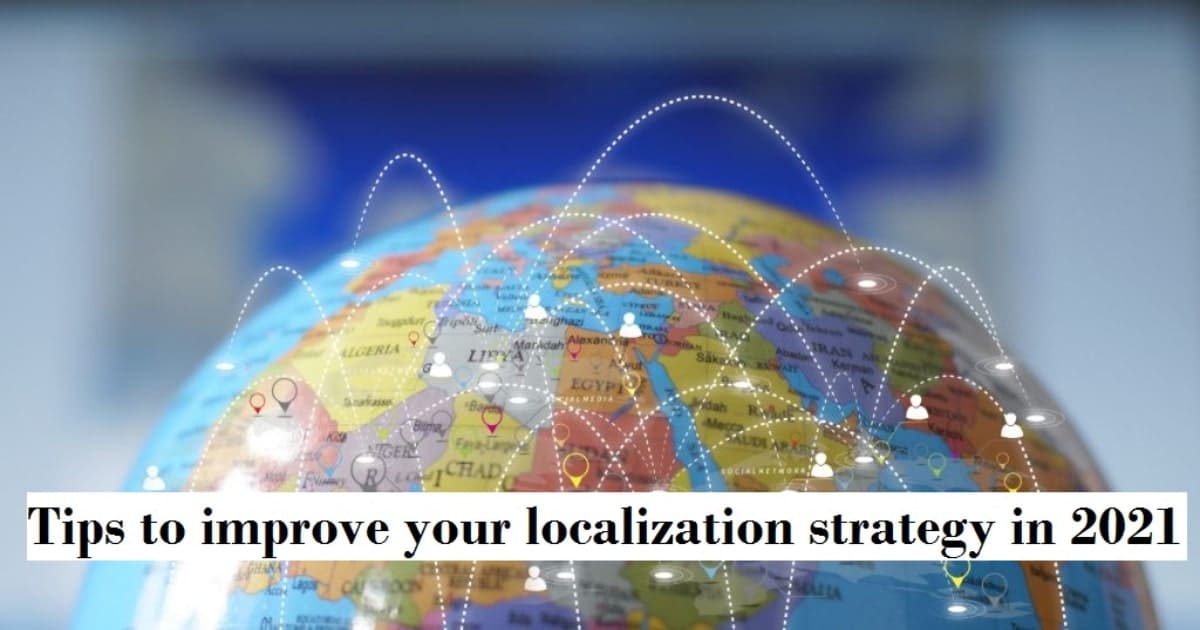
Tips to improve your localization strategy in 2023
Introduction
In a globalized world, businesses are increasingly targeting
international markets to expand their reach and boost their revenue. A key
aspect of succeeding in international markets is a well-executed localization
strategy. Localization involves adapting your products or services to meet the
cultural, linguistic, and functional requirements of specific target markets.
This article will provide valuable tips and insights to enhance your
localization strategy in 2023 and effectively connect with your international
audience.
1. Understanding Localization
To improve your localization strategy, it's crucial to have
a solid understanding of what localization entails. Localization goes beyond
translation and involves tailoring your content, design, and user experience to
suit the preferences and expectations of your target audience. It requires a
deep understanding of the local culture, language, and market dynamics.
2. Importance of Localization
Localization is essential for building trust, increasing
customer engagement, and driving conversions in international markets. By
speaking your customers' language and addressing their cultural sensitivities,
you demonstrate respect and establish a connection with them. Localization also enables you to adapt
your offerings to local regulations, preferences, and market trends, giving you
a competitive edge.
3. Market Research and Analysis
Before expanding into new markets, conduct thorough market
research and analysis. Identify target countries, assess market potential,
analyze competitors, and understand the local consumer behavior. This research
will help you determine which markets offer the greatest opportunities and
enable you to tailor your localization strategy accordingly.
4. Adapting Cultural Nuances
Cultural nuances play a significant role in localization.
Take the time to understand the customs, traditions, and values of your target
market. Adapt your content, visuals, and messaging to align with the local
culture while avoiding any potential pitfalls or offensive references. This
level of cultural sensitivity will resonate with your audience and enhance your
brand reputation.
5. Language Localization
Accurate and high-quality
translation is a cornerstone of effective localization. Work with
professional translators who are native speakers of the target language and
have expertise in your industry. Ensure that your translated content is
culturally appropriate and maintains the intended meaning and tone.
Localization tools and platforms can also streamline the translation process
and ensure consistency across multiple languages.
6. User Experience Optimization
Optimizing the user experience (UX) is crucial for
successful localization. Localize your website or app's interface, navigation,
and user interactions to align with the expectations of your target audience.
Consider factors such as date formats, time zones, currency symbols, and
address formats. Conduct usability tests to identify any potential issues and
gather feedback from local users.
7. Local SEO and Keywords
To improve your visibility in local search engine results,
implement local search engine optimization (SEO) strategies. Conduct keyword
research specific to each target market and optimize your content, meta tags,
headings, and URLs accordingly. Localize your SEO efforts to capture relevant
search traffic and ensure your website ranks well in local searches.
8. Website Localization
Localization should extend to your entire website. Translate
and adapt all your website content, including landing pages, product
descriptions, blog posts, and customer reviews. Customize visuals, colors, and
graphics to resonate with the local audience. Ensure that your website's layout
is responsive and user-friendly on different devices and browsers.
9. Mobile App Localization
If you have a mobile app, don't overlook its localization.
Translate the app's user interface, notifications, and in-app content. Consider
localizing app store descriptions, screenshots, and app preview videos to
entice potential users. Adapt the app's functionality to suit local preferences
and integrate with local payment gateways or social media platforms.
10. Social Media Localization
Social media platforms are powerful channels for reaching
global audiences. Localize your social media profiles, posts, and
advertisements to engage with local communities effectively. Use
region-specific hashtags, collaborate with local influencers, and encourage
user-generated content in different languages. Monitor and respond to local
social media conversations promptly.
11. Content Localization
Localization extends to all forms of content you create,
such as articles, videos, podcasts, and infographics. Adapt your content to
suit local preferences, cultural references, and storytelling techniques.
Tailor your messaging and storytelling to resonate with the target audience's
values, aspirations, and pain points. Leverage local trends and topics to
create relevant and shareable content.
12. Testing and Quality Assurance
Thorough testing and quality assurance are vital to ensure a
seamless localized experience. Test your localized website, app, and content
across multiple devices, platforms, and browsers. Check for linguistic
accuracy, functional integrity, and visual consistency. Seek feedback from
local users and make necessary adjustments to optimize the user experience.
13. Continuous Improvement
Localization is an ongoing process that requires constant
monitoring and improvement. Regularly analyze performance metrics, gather
customer feedback, and adapt your strategy based on market dynamics. Stay
updated on cultural and linguistic changes, emerging trends, and technological
advancements that can enhance your localization efforts.
Conclusion
In today's global marketplace, a well-executed localization
strategy is key to successfully expanding your business into international
markets. By understanding the importance of localization, conducting thorough
market research, adapting to cultural nuances, optimizing user experiences, and
localizing your content, you can effectively connect with your target audience
and drive business growth.
FAQs-
- How
long does it take to implement a localization strategy?
The time required to implement a localization strategy
depends on various factors such as the complexity of your content, target
languages, and available resources. It's essential to plan ahead and allocate
sufficient time for translation, adaptation, and quality assurance processes.
2.Can I use machine translation for
localization?
While machine translation has improved significantly, it's
still recommended to work with professional human translators for localization.
Human translators have a better understanding of cultural nuances and can
ensure accurate and contextually appropriate translations.
3.How can I measure the success of my localization
strategy?
To measure the success of your localization strategy, track
key performance indicators (KPIs) such as website traffic, engagement metrics,
conversion rates, and customer feedback. Analyze the impact of localization on
your business goals and make data-driven decisions to optimize your strategy.
4.What are the common challenges in localization?
Some common challenges in localization include linguistic
and cultural nuances, maintaining brand consistency across different languages,
coordinating translation efforts, and staying updated with evolving market
dynamics. Working with experienced localization professionals can help overcome
these challenges.
5.Should I localize all my content for every
market?
It's important to prioritize and focus your localization
efforts based on market research and business goals. Not all content may
require localization for every market. Identify key assets and customer
touchpoints that have the most impact on your target audience and prioritize
their localization.




